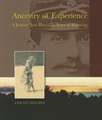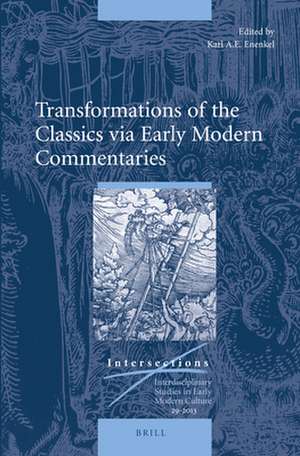Transformations of the Classics via Early Modern Commentaries: Intersections, cartea 29
Editat de Karl A. E.. Enenkelen Limba Engleză Hardback – 28 noi 2013
Contributors include: Susanna de Beer, Valéry Berlincourt, Marijke Crab, Jeanine De Landtsheer, Karl Enenkel, Gergő Gellérfi, Trine Arlund Hass, Ekaterina Ilyushechkina, Ronny Kaiser, Marc Laureys, Christoph Pieper, Katharina Suter-Meyer, and Floris Verhaart.
Din seria Intersections
-
 Preț: 217.51 lei
Preț: 217.51 lei -
 Preț: 174.49 lei
Preț: 174.49 lei -
 Preț: 200.26 lei
Preț: 200.26 lei -
 Preț: 215.61 lei
Preț: 215.61 lei -
 Preț: 98.61 lei
Preț: 98.61 lei -
 Preț: 192.18 lei
Preț: 192.18 lei -
 Preț: 154.86 lei
Preț: 154.86 lei -
 Preț: 116.09 lei
Preț: 116.09 lei - 18%
 Preț: 1074.49 lei
Preț: 1074.49 lei -
 Preț: 241.64 lei
Preț: 241.64 lei -
 Preț: 241.64 lei
Preț: 241.64 lei -
 Preț: 228.96 lei
Preț: 228.96 lei -
 Preț: 229.55 lei
Preț: 229.55 lei -
 Preț: 241.64 lei
Preț: 241.64 lei -
 Preț: 226.67 lei
Preț: 226.67 lei -
 Preț: 107.21 lei
Preț: 107.21 lei -
 Preț: 208.79 lei
Preț: 208.79 lei -
 Preț: 201.78 lei
Preț: 201.78 lei -
 Preț: 226.85 lei
Preț: 226.85 lei -
 Preț: 225.71 lei
Preț: 225.71 lei -
 Preț: 246.63 lei
Preț: 246.63 lei - 47%
 Preț: 319.92 lei
Preț: 319.92 lei - 7%
 Preț: 315.66 lei
Preț: 315.66 lei -
 Preț: 96.10 lei
Preț: 96.10 lei - 18%
 Preț: 1201.75 lei
Preț: 1201.75 lei - 18%
 Preț: 659.69 lei
Preț: 659.69 lei - 18%
 Preț: 693.26 lei
Preț: 693.26 lei - 18%
 Preț: 1049.43 lei
Preț: 1049.43 lei - 18%
 Preț: 698.32 lei
Preț: 698.32 lei - 18%
 Preț: 681.99 lei
Preț: 681.99 lei - 18%
 Preț: 687.25 lei
Preț: 687.25 lei - 18%
 Preț: 820.59 lei
Preț: 820.59 lei - 18%
 Preț: 683.37 lei
Preț: 683.37 lei - 18%
 Preț: 667.86 lei
Preț: 667.86 lei
Preț: 953.05 lei
Preț vechi: 1162.26 lei
-18% Nou
Puncte Express: 1430
Preț estimativ în valută:
182.38€ • 189.33$ • 152.08£
182.38€ • 189.33$ • 152.08£
Carte indisponibilă temporar
Doresc să fiu notificat când acest titlu va fi disponibil:
Se trimite...
Preluare comenzi: 021 569.72.76
Specificații
ISBN-13: 9789004260771
ISBN-10: 9004260773
Pagini: 417
Dimensiuni: 155 x 235 x 25 mm
Greutate: 0.84 kg
Editura: Brill
Colecția Brill
Seria Intersections
ISBN-10: 9004260773
Pagini: 417
Dimensiuni: 155 x 235 x 25 mm
Greutate: 0.84 kg
Editura: Brill
Colecția Brill
Seria Intersections
Cuprins
Acknowledgements ......................................................................................... vii
Notes on the Editor ......................................................................................... ix
Notes on the Contributors ............................................................................ xi
List of Illustrations ........................................................................................... xv
Introduction – The Transformation of the Classics. Practices,
Forms, and Functions of Early Modern Commenting .................... 1
. Karl A.E. Enenkel
POETRY
Horace and Ramist Dialectics: Pierre Gaultier Chabot’s
(1516–1598?) Commentaries ..................................................................... 15
. Floris B. Verhaart
Changing Metatexts and Changing Poetic Ideals .................................. 47
. Trine Arlund Hass
Horaz als Schulfibel und als elitärer Gründungstext des deutschen
Humanismus. Die illustrierte Horazausgabe des Jakob Locher
(1498) .............................................................................................................. 61
. Christoph Pieper
Petrus Nannius als Philologe und Literaturkritiker im Lichte seines
Kommentars zur Ars Poetica des Horaz .............................................. 91
. Marc Laureys
Scholarly Polemic: Bartolomeo Fonzio’s Forgotten Commentary
on Juvenal ..................................................................................................... 111
. Gergő Gellérfi
Commenting on Claudian’s ‘Political Poems’, 1612/1650 ...................... 125
. ValÉry Berlincourt
HISTORY AND MORAL PHILOSOPHY
Josse Bade’s Familiaris Commentarius on Valerius Maximus (1510):
A School Commentary? ............................................................................ 153
. Marijke Crab
Illustrations as Commentary and Readers’ Guidance.
The Transformation of Cicero’s De Officiis into a German
Emblem Book by Johann von Schwarzenberg, Heinrich Steiner,
and Christian Egenolff (1517–1520; 1530/1531; 1550) ........................... 167
. Karl A.E. Enenkel
Understanding National Antiquity. Transformations of Tacitus’s
Germania in Beatus Rhenanus’s Commentariolus ............................ 261
. Ronny Kaiser
Annotating Tacitus: The Case of Justus Lipsius ..................................... 279
. Jeanine De Landtsheer
NATURAL HISTORY AND GEOGRAPHY
The Survival of Pliny in Padua. Transforming Classical Scholarship
during the Botanical Renaissance ......................................................... 329
. Susanna de Beer
Elephants and Bears through the Eyes of Scholars: A Case Study
of Pliny’s Zoology in the 15th–16th Centuries .................................... 363
. Ekaterina Ilyushechkina
Frühneuzeitliche Landesbeschreibung in einer antiken
Geographie – Der Rhein aus persönlicher Perspektive in
Vadians Kommentar zu Pomponius Mela (1522) .............................. 389
. Katharina Suter-Meyer
Index Nominum ............................................................................................... 411
Notes on the Editor ......................................................................................... ix
Notes on the Contributors ............................................................................ xi
List of Illustrations ........................................................................................... xv
Introduction – The Transformation of the Classics. Practices,
Forms, and Functions of Early Modern Commenting .................... 1
. Karl A.E. Enenkel
POETRY
Horace and Ramist Dialectics: Pierre Gaultier Chabot’s
(1516–1598?) Commentaries ..................................................................... 15
. Floris B. Verhaart
Changing Metatexts and Changing Poetic Ideals .................................. 47
. Trine Arlund Hass
Horaz als Schulfibel und als elitärer Gründungstext des deutschen
Humanismus. Die illustrierte Horazausgabe des Jakob Locher
(1498) .............................................................................................................. 61
. Christoph Pieper
Petrus Nannius als Philologe und Literaturkritiker im Lichte seines
Kommentars zur Ars Poetica des Horaz .............................................. 91
. Marc Laureys
Scholarly Polemic: Bartolomeo Fonzio’s Forgotten Commentary
on Juvenal ..................................................................................................... 111
. Gergő Gellérfi
Commenting on Claudian’s ‘Political Poems’, 1612/1650 ...................... 125
. ValÉry Berlincourt
HISTORY AND MORAL PHILOSOPHY
Josse Bade’s Familiaris Commentarius on Valerius Maximus (1510):
A School Commentary? ............................................................................ 153
. Marijke Crab
Illustrations as Commentary and Readers’ Guidance.
The Transformation of Cicero’s De Officiis into a German
Emblem Book by Johann von Schwarzenberg, Heinrich Steiner,
and Christian Egenolff (1517–1520; 1530/1531; 1550) ........................... 167
. Karl A.E. Enenkel
Understanding National Antiquity. Transformations of Tacitus’s
Germania in Beatus Rhenanus’s Commentariolus ............................ 261
. Ronny Kaiser
Annotating Tacitus: The Case of Justus Lipsius ..................................... 279
. Jeanine De Landtsheer
NATURAL HISTORY AND GEOGRAPHY
The Survival of Pliny in Padua. Transforming Classical Scholarship
during the Botanical Renaissance ......................................................... 329
. Susanna de Beer
Elephants and Bears through the Eyes of Scholars: A Case Study
of Pliny’s Zoology in the 15th–16th Centuries .................................... 363
. Ekaterina Ilyushechkina
Frühneuzeitliche Landesbeschreibung in einer antiken
Geographie – Der Rhein aus persönlicher Perspektive in
Vadians Kommentar zu Pomponius Mela (1522) .............................. 389
. Katharina Suter-Meyer
Index Nominum ............................................................................................... 411
Notă biografică
Karl Enenkel is Professor of Medieval Latin and Neo-Latin at the Westfälische Wilhelms-Universität Münster (Germany). Previously he was Professor of Neo-Latin at the University of Leiden (Netherlands). He has published widely on international Humanism, early modern organisation of knowledge, literary genres 1300-1600, and emblem studies.
Recenzii
“The real tour de force in the volume is the ninety-four-page essay of its editor, Karl Enenkel, who also wrote the grant to the Dutch Organization for Scientific Research that supported five of the authors ... Enenkel argues (quite convincingly) that illustrations to early modern printed editions can also serve as a kind of commentary … We owe thanks to him for the vision and hard work that has produced what is considerably more on the scholarly level than just another set of conference papers, and to Brill for producing a well-printed volume that is enriched with dozens of illustrations (over forty in Enenkel’s article alone).”
Craig Kallendorf, Texas A&M University. In: Renaissance Quarterly, Vol. 67, No. 4 (Winter 2014), pp. 1303-1305.
“enormously helpful … beautifully presented, well-made … an excellent collection of thoughtful and stimulating essays.”
Jon Balserak, University of Bristol. In: Sixteenth Century Journal, Vol. 46, No. 2 (2015), pp. 430-431.
Craig Kallendorf, Texas A&M University. In: Renaissance Quarterly, Vol. 67, No. 4 (Winter 2014), pp. 1303-1305.
“enormously helpful … beautifully presented, well-made … an excellent collection of thoughtful and stimulating essays.”
Jon Balserak, University of Bristol. In: Sixteenth Century Journal, Vol. 46, No. 2 (2015), pp. 430-431.
